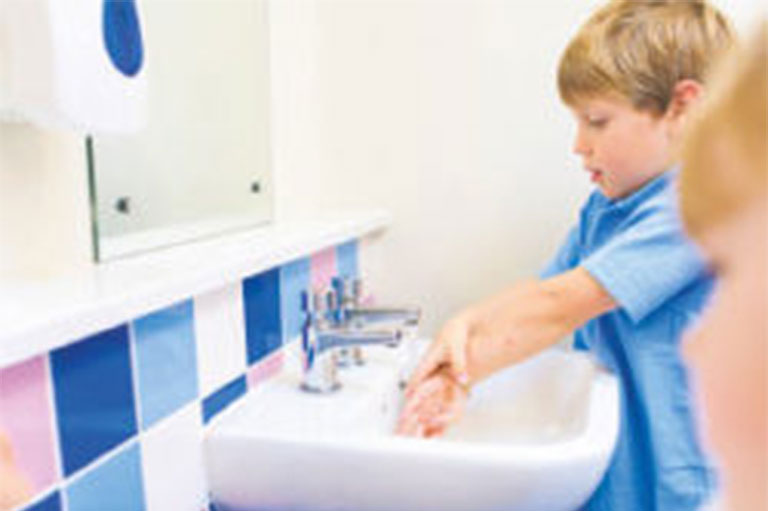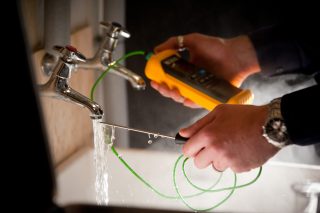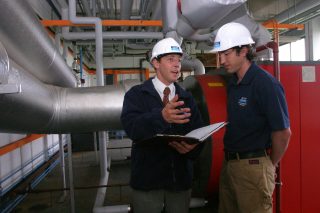Thermostatic mixer valve (TMV) servicing
What are Thermostatic mixer valves?
What are TMV’s and when do they need to be serviced? Thermostatic mixer valves (TMV’s) are devices used to accurately control the temperature of water by blending hot and cold water to a set temperature between 38°c and 46°c to prevent the risk of scalding. Scalding can occur within seconds, especially with vulnerable users, by installing TMV’s ensures water is provided at a safe temperature.
What is the impact of a Thermostatic mixer valves on Legionella control?
The most common way to prevent legionella bacteria is through the control of temperature within hot and cold-water systems. Hot water must be stored at above 60°c as this will kill off any legionella bacteria in the system, and hot water temperatures must reach 50°c at the outlets to manage the risk of legionella bacteria. However, the problem of scalding arises as clearly water at these temperatures could cause scalding, so this is where the two risks namely, legionella risk and scalding risk must be considered together and a solution found.
TMV’s are often used as a solution to prevent scalding but can themselves increase the legionella risk if not managed and maintained correctly.
The water in pipework downstream of a TMV being less than 50°c could provide a suitable environment in which legionella bacteria could multiply and therefore increase the legionella risk. So, it is important to ensure TMV’s are installed as close as possible (less than 2m) to the outlet to reduce the legionella risk, while also managing the scalding risk.
Always consider whether the TMV is actually required, during the Legionella risk assessment the scalding risk will be compared to the legionella risk, if the scalding risk is considered insignificant then the TMV should be removed.
5 points to consider when fitting Thermostatic mixer valves
- The TMV should be part of the tap fitting if possible, to mix the water at the outlet.
- The legionella risk will be increased if a TMV is fitted to a low flow spray tap.
- The TMV should be fitted as close (within 2m) as possible to the outlet to reduce the volume of stored water in the pipework.
- The legionella risk is increased if the TMV valve feeds more than one outlet, for example, a bank of showers or wash hand basins.
- A TMV can inadvertently make a cold tap become little-used outlet that will need to be flushed weekly.
When should a Thermostatic mixer valves be fitted?
- TMV’s should be installed within areas that present a high risk of scalding especially with full body immersion such as Baths and showers and particularly with very young or elderly people.
- TMV’s can also be fitted to wash hand basins and sinks where a significant scalding risk has been identified, for example in properties with very young or very old people or in properties with mentally or physically disabled people.
- TMV’s are required in all healthcare premises for example hospitals and healthcare centres.
When do my Thermostatic mixer valves need to be serviced?
The valves need to be checked on an annual basis or at a frequency defined by the risk assessment. It is important to ensure the valves are working correctly and will offer protection against scalding.
In hospitals, different regulations apply, and checks are bi-annual.
What is the difference between a type 2 Thermostatic mixer valves and a type 3 Thermostatic mixer valves?
Type 2 TMV can be overridden by the user. Type 2 TMV’s are only suitable for domestic situations and housing associations for able-bodied people. Products meet the standards BS EN 1111 and or BS EN 1287.
Type 3 TMV complies with the NHS document D 08 and has a pre-set temperature are fail-safe and cannot be overridden by the user. Type 3 TMV’s are required in healthcare premises. They are specified in the NHS Estates Model Engineering Specification Thermostatic mixing valves (healthcare premises).
For further information:
Health Technical Memorandum (HTM) 04-01 The control of Legionella, hygiene, ‘safe’ hot water, cold water, and drinking water systems Department of Health ‘Space for Health’ website (registration required) www.spaceforhealth.nhs.uk
HSE Managing the risks from hot water and surfaces in health and social care http://www.hse.gov.uk/pubns/hsis6.pdfThermostatic mixer valve (TMV) servicing
Please give our team a call on 01454 417 920 to discuss any aspect of TMV servicing or visit https://www.dantekenvironmental.co.uk/services/plant-equipment/tmv-servicing/ for more information






